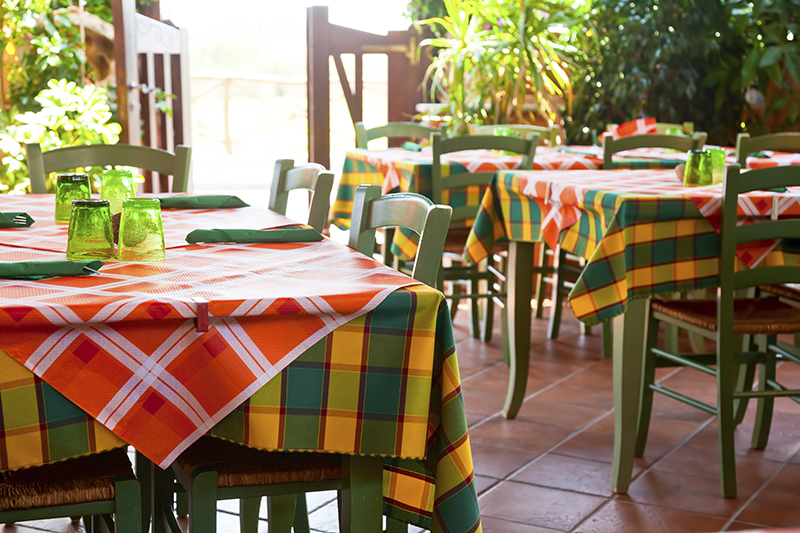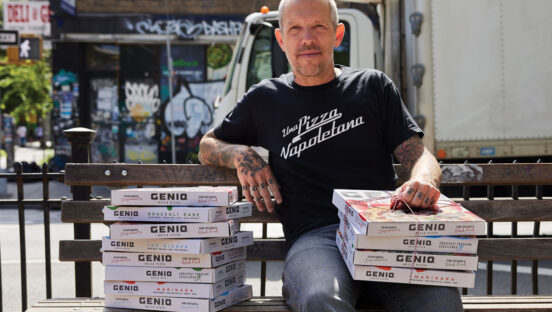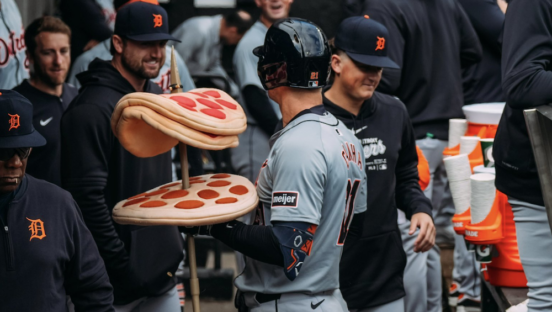Editor’s note: This article originally appeared in a 2003 issue of PMQ Pizza Magazine. It was penned by the late, legendary pizzeria operator and industry consultant Big Dave Ostrander. As an introduction to launching a pizza restaurant, most of the information contained here is just as relevant today as it was 20 years ago (all that’s missing are digital ordering and social media). So we’re republishing it for those industry newcomers seeking great advice about starting their first-ever pizza restaurant.
By Big Dave Ostrander
Opening a pizzeria is a lot more complicated than it appears. I have opened seven for myself and dozens for clients. Every one is similar, but they all are unique to themselves. For those of you who are already successful in the business, you’ll say amen to many of the hoops listed here because you had to jump through them yourself. For those who are contemplating it, this will be a basic primer.
Before the first pizza is sold, you’ll need to deal with 20 to 30 critical decisions and tasks. Skip them at your risk! This list is in no particular order because many of them are happening simultaneously. Here are some of the steps and decision points.
- Analyze the Competition and Area. See if it can support another pizzeria. What you’re looking for is a town that buys a lot of pizza or a town that is grossly underserved with below average pizza. Finding out their gross sales is very helpful. Sometimes an owner or employee will volunteer the information if they don’t feel threatened. Sometimes I videotaped the food being delivered from the distributor’s truck and multiplied the total in dollars by three to get a feel of weekly sales. The way the chains do it is similar, but they plant a mole in your parking lot or dining room to do car counts and hourly sales estimates and compare these figures to theirs. Many food service salesmen will disclose this information to you in a hypothetical way. At one time, I had an acquaintance at the Department of Treasury who would tell me how much sales tax was paid by an establishment. They couldn’t disclose the sales, but the tax info was ethical.
- Locate Several Possible “Best Locations.” I suggest you send in another person to represent you in discussions with real estate people. Until you finalize the best location, you don’t want to be associated with the rumor mill. As soon as somebody comes to town and starts to do diligent inquiries on rental property for a pizzeria, the rumor mill explodes. Within six hours every pizza operator will have all of the information. You don’t want to tip your hand to potential competitors, so remain anonymous until you are ready to commit.
- Determine Your Style of Service. Will you offer dine-in, carry out, delivery, take & bake, self-service, full service, etc.? Each of these options requires slightly different building needs.
- Design and Cost Out Your First Menu. Do a thorough food cost breakdown on every entrée. You must know how much it costs to make everything and how much gross profit per item you’ll be generating on each transaction. While you’re weighing out toppings and ingredients, foodservice distributors will need to provide you with pricing on specific foods you’ll be buying.
- Name the Baby. What are you going to call your place? Names are important. Choose one that is memorable. Archibald Leech became Cary Grant, Cherilyn Shakisian became Cher. Brothers-in-law Ron Smoljanivich and Matt Zagula became Tony Tomato’s in Weirton, West Virginia. Don’t be too vague or too narrow. Do a name search through the state and federal agencies to make sure the name you love isn’t already taken. Then register the name and decide what type of business entity you’ll be doing business. Will you be a sole proprietorship, partnership, S Corp, LLC or regular C-Corporation? This decision should be made with a tax professional. Have an attorney do the registration. While we’re on identity, design your logo and register it.
- Your Unique Selling Proposition (USP). Describe who you are and what you do in a USP (unique selling proposition). Example: “Tony Tomato’s – Finally…Pizza Made By Chefs!” Your town does not need another crappy pizza place. Be a quality fanatic and create something better and different. When you describe your pizza, it better have a believable story on who, what and why your pie is praiseworthy. This is your USP in the long version. You have to tell a story or you’ll be stereotyped, and price alone will determine who makes it and who fails.
- Budgets. Create a capital budget, proforma, equipment, and ‘build’ budget. There is nothing worse than running out of money before you open. Secure conventional or unconventional financing. Under-capitalization is one of the biggest reasons for failure in the restaurant business. Plan on having enough money left over for operating capital when you open. Most places don’t generate a solid profit for three to six months or longer after opening.
- Negotiate the Lease. Have an attorney review the lease agreement for any possible bombshells. Before you sign, realize that commercial leases are the real deal. You can’t leave in the middle of the night if things don’t go as planned. Courts will enforce them, and you’ll probably be signing personally as well as corporately. Check out local ordinances that deal with signage, parking, occupancy, water and sewer rates.
- Choose, Source Out and Price Equipment. Negotiate pricing and guarantees on any used or re-conditioned equipment. Start your cut sheet book that you’ll be needing for the health department and skilled trades. These sheets will give all of the power requirements, sizes, make and model numbers.
- Design the Floor Plan. Make sure all of the stuff will fit and the flow of people and product will be smooth. Your city or town may require professional mechanical and architectural sealed drawings before they issue a building permit.
- Apply for state sales tax and federal ID numbers. Identifying numbers are required to open a commercial checking account and get a credit card account. While we’re dealing with the government, you might as well get used to the building and health departments.
- Choose Skilled Tradesmen. Plumbers, electricians, refrigeration and carpenters will be asking you dozens of questions. Choose someone who is highly referred and is pleasing to work with. Some of these folks lie a lot. Once a price has been settled, negotiate the absolute drop-dead date their work has to be completed. I always included a penalty clause when I negotiated services. If their portion of the job was held up or wasn’t completed on the agreed date, they gave me permission, in writing, to deduct a per-day fine of between $200 and $500. Conversely, I paid them on time.
- Get the Utilities Turned On. Be ready for security deposits. Choose a very cool phone number if possible. Don’t settle for the first one they assign you, but request the business office email or fax you a list of available numbers in your town. Choose the one that is easily remembered. RE: 888 – BIG – Dave.
- Develop a Marketing Plan. Put this down in writing with deadlines. How will I invest my money to achieve the biggest bang for my buck and achieve “awareness, trial and repeat” from a customer base of 10 people? (Editor’s update: Also research and purchase a domain name for your website. If your new pizzeria doesn’t have a website in 2022, you’re already way behind your competitors.)
- Interview Foodservice Distributors. Choose a primary and secondary distributor. This choice will be based on rapport with the rep, pricing, out-of-stock ratios and frequency of delivery. Create an opening order and set up a reorder guide.
Just think, we’re having this much fun and have never even thought about pizza. Let’s get focused on the product.
THE TONY TOMATO’S CASE STUDY
Learn all of the recipes and procedures for dough, sauce, cheese, toppings and other items on your menu. Suppliers will be sampling different items for comparison. They may also bring in a broker rep that is knowledgeable in specific product lines. These folks are commissioned, so believe every word they speak.

Ron and Matt of Tony Tomato’s had done everything on the list of to-do’s in preparation for my arrival as their consultant. We made dough, sauce and learned the mechanics of the food. Ron is a chef and is very comfortable around food but had never made a pizza in his career. This exposure to different styles of pizza, ovens, menu items and conversations with successful operators helped him choose the stuff he would be using.
In the next three months the brothers and I exchanged dozens of calls, faxes and e-mails. When I arrived at their location in Weirton, they really impressed me. A couple of tweaks here and there, a couple of run-ins with Murphy’s Law, and we were jammin’. Art and Lois had worked with Ron in fine dining and was all the crew we had actually hired four days before opening. We got right to it and the recipes started flying. I had already placed the opening order with the distributor and was very comfortable with the ingredients we would be using. We chose to brand Tony Tomato’s as a high-end spot for pizza, made with the finest and freshest ingredients money could buy, priced very affordable. With my knowledge base in ingredients, I had samples FedExed to them in advance.
There is no better training than hands on. Recipes are plentiful, but the management of the ingredients is vital.
- Countdown to the Big Day. Choose what day you’ll open on and keep it sacred. Interview and hire your crew and get all of the equipment up and running. Murphy’s Law of pizzeria openings will probably rear its ugly head, but stick to the plan.
- Grand Opening. Public Relations First – Marketing Second. Marketing lacks credibility, the crucial ingredient is brand building. Only PR can supply that credibility. Marketing should only be used to maintain brands once they have been established through publicity.
- Doing PR. Customers are already over-saturated with marketing and advertising every day. Your stuff will pretty much go unnoticed, unless it’s unique. One month prior to opening, you should start creating a buzz. You control the message people hear at this stage. This is how we did it at Tony Tomato’s last spring.
Three weeks before opening, as we were proofing the final copy of their beautiful flyer. Matt asked me for a quote we could use as a testimonial. I had never been asked that and asked why. Matt said, “We want to create curiosity in town and figured we would tap into your brand. You are perceived to be a pizza industry legend.” I was pretty self-conscious. I’ve been called many things, but never a legend. We decided on the quote:
“Tony Tomato’s will take Ohio Valley pizza to new heights. Words can’t describe it, and believe me I know great pizza.” Pizza Industry Legend Big David Ostrander.
They were starting positive word of mouth. People were asking questions, and they told their unique story. They had started their brand awareness.
CREATING PUBLICITY OPPORTUNITIES
On Thursday evening Ron and Matt invited friends, family, movers and shakers in town and every member of the Weirton Chamber of Commerce to join us for a private wine and pizza party at the shop. The guests started to arrive at 4 o’clock. By 5, the lobby area was packed, and we were putting out excellent pizza to rave reviews. Matt asked me if I would do some kitchen tours. “Bring them on,” I said.
I decided to tell the guest the “who, what and why” about Tony Tomato’s. I started by showing them the brand new deck ovens and told them why I thought decks baked a crispier crust. Then I described how we made fresh dough every day in that Hobart 80-quart mixer. I showed them how we hand-rolled every dough ball. Sure, we could buy frozen dough, but you lose a little bit of freshness and quality.

Then I described the pizza sauce, made from fresh tomatoes, not from paste like most places. I opened a can of whole ground tomatoes and did a role-play and let them taste it. That did it. The hook was set. Their eyes glazed over when they tasted the tomatoes. I told them how we blended three cheeses to achieve the flavor, stretch and melt. Then I gave them a fresh hot bread stick, right out of the oven, basted with garlic butter and sprinkled with fresh Parmesan and invited them to dip it in to our homemade, fresh ranch Dressing. “Sure, we could buy the bottled stuff but we don’t think it matches up. What do you think?” They couldn’t wait to tell our story for us at the first opportunity. I did this tour for almost every guest.
Out of the blue, the local television camera crew shows up looking for a story. Rumor had it we were having a tasting party and they asked if we would mind if they did a story for the 11 o’clock news? I was having a hard time curbing my enthusiasm. One word of positive media coverage is worth 10 words of paid advertising. Right after the TV crew left, I was introduced to the editor of the local newspaper. I gave him the whole enchilada, and we scheduled an interview for the next day. Tony Tomato’s was the lead story that night on TV, and the newspaper interview turned into a half page story with photos in the Sunday edition. The town was talking and the buzz had started.
After I left, I tried to call the restaurant from the Detroit airport, but the phones were busy. I finally got through at 10 p.m. Ron and Matt said sales were phenomenal.
They closed early. Why? “We ran out of dough.” “All 500 pieces?” “Yes.”
Copyright © 2003 Dave Ostrander, all rights reserved.















